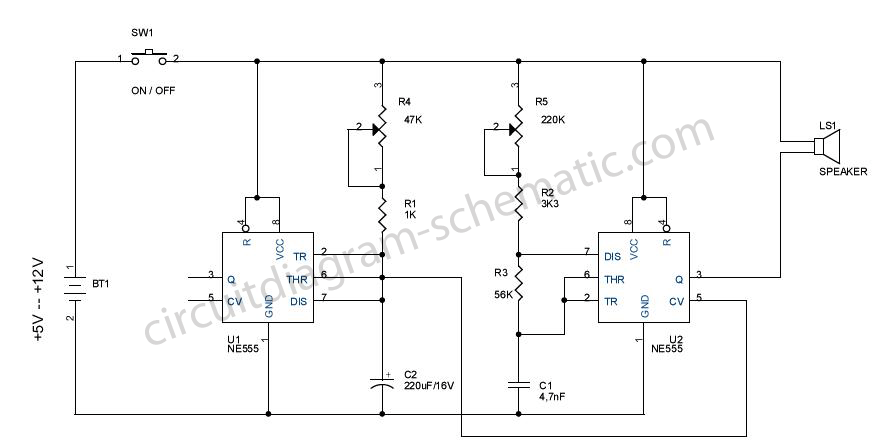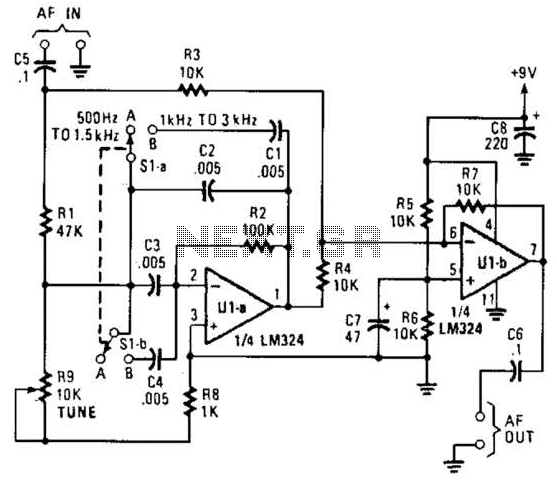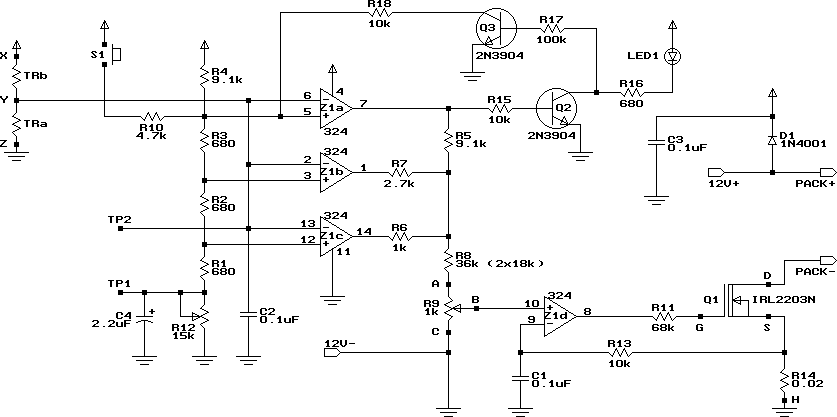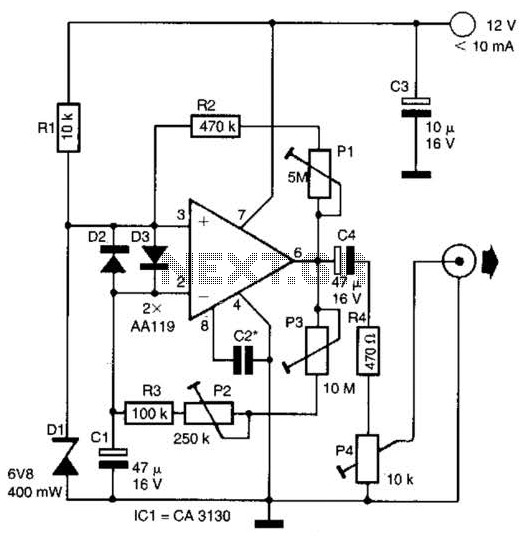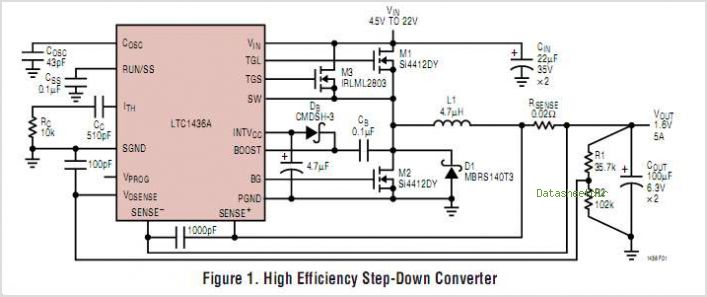
Noise Suppression For R/C Receivers
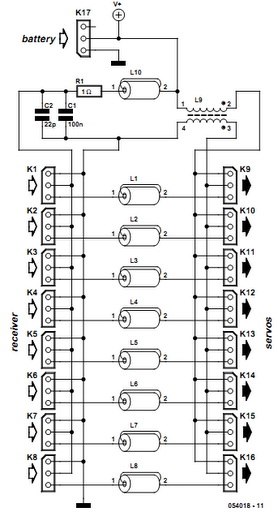
Receiver interference is a common issue among model builders. Preventive measures, such as ferrite beads fitted to servo cables, are frequently employed in larger models and electrically driven models to prevent the cables from acting as antennas and radiating interference to the receiver. To use miniature ferrite beads for this purpose, the connector must first be disassembled, allowing the lead to be threaded through the bead (potentially making several turns around the core) before being soldered back onto the connector. Additionally, interference can also affect the receiver through the power supply connection. Typically, the battery connects directly to the receiver, with the servos powered through the receiver. Since servos can draw high currents during operation, they can introduce significant noise into the supply line. This type of interference can be mitigated by isolating the supply voltage for the receiver from that of the servos. While these measures can be implemented loosely within the model, it is preferable to integrate everything onto a single small circuit board for a neater appearance and reduced space requirements. The schematic diagram illustrates this setup. Connectors K1 to K8 are positioned on the left side as inputs for the servo signals, which connect to the receiver via servo leads. Outputs K9 to K16 are located on the right side, where the servos are connected. The battery connects to K17. Interference on the supply voltage line, caused by motors and servos, is suppressed by a filter composed of L10, R1, C1, and C2. L10 is a ferrite-core coil with an impedance of 2000 ohms at 30 MHz. Together with C1 and C2, it creates a significant barrier against interference in the 35-MHz R/C band. The filter also effectively blocks signals with frequencies near the 10.4-MHz intermediate frequency, commonly used in many receivers. L9 filters out common-mode noise on the supply line for the servos, preventing the supply lines from functioning as antennas. Furthermore, high-frequency currents on the servo signals are filtered out using ferrite beads to minimize the antenna effects of these connection lines.
The circuit design effectively addresses the challenge of receiver interference by employing a combination of ferrite beads, inductors, resistors, and capacitors strategically arranged on a compact circuit board. The use of ferrite beads on the servo leads serves to attenuate high-frequency noise, which is crucial for maintaining signal integrity, especially in applications where precise control is required. The isolation of power supply lines ensures that the noise generated by the servos does not compromise the performance of the receiver, which is essential for reliable operation in remote-controlled models.
In the schematic, the arrangement of components is critical for optimal performance. The ferrite-core inductor L10, rated at 2000 ohms at 30 MHz, is vital for suppressing high-frequency noise while maintaining the necessary current flow for the servos. Capacitors C1 and C2 work in conjunction with L10 to form a low-pass filter, effectively shunting high-frequency interference to ground. Resistor R1 may serve to dampen oscillations or further refine the filtering effect depending on the specific characteristics of the circuit.
The circuit board layout should prioritize short traces and minimal loop areas to reduce inductive coupling, which could introduce additional noise. Proper grounding techniques, including a solid ground plane, are essential to ensure that the filtering capabilities of the circuit are maximized. The inclusion of connectors K1 to K17 allows for easy integration with the receiver and servos, facilitating maintenance and upgrades to the system.
Overall, this design not only enhances the performance of the model by reducing interference but also contributes to a more organized and compact assembly, which is beneficial for both aesthetics and functionality in remote-controlled applications.Receiver interference is hardly an unknown problem among model builders. Preventive measures in the form of ferrite beads fitted to servo cables are often seen in relatively large models and/or electrically driven models, to prevent the cables from acting as antennas and radiating interference to the receiver. If miniature ferrite beads are used f or this purpose, the connector must be first be taken apart, after which the lead must be threaded through the bead (perhaps making several turns around the core) and then soldered back onto the connector. An interference source can also cause problems in the receiver via the power supply connection. The battery is normally connected directly to the receiver, with the servos in turn being powered from the receiver.
The servos can draw high currents when they operate, which means they can create a lot of noise on the supply line. This sort of interference can be kept under control by isolating the supply voltage for the receiver from the supply voltage for the servos.
All of these measures can easily be implemented loose` in the model, but it`s a lot nicer to fit everything onto a single small circuit board. That makes everything look a lot tidier, and it takes up less space. The schematic diagram is shown in Figure 1. Connectors K1 K8 are located at the left. They are the inputs for the servo signals, which are connected to the receiver by the servo leads. The outputs (K9 K16) are located on the right. That is where the servos are connected. Finally, the battery is connected to K17. Interference on the supply voltage line due to the motors and servos is suppressed by a filter formed by L10, R1, C1 and C2.
L10 is a ferrite-core coil with an impedance of 2000 ohms at 30 MHz. In combination with C1 and C2, it forms a substantial barrier to interference in the 35-MHz R/C band. Signals with frequencies close to the 10. 4-MHz intermediate frequency (which is used in many receivers) are also effectively blocked by this filter.
L9 filters out common-mode noise on the supply line for the servos, which effectively means that it prevents the supply lines to the servos from acting as antennas. Finally, high-frequency currents on the servo signals are filtered out by ferrite beads in order to limit the antenna effects of these connection lines.
🔗 External reference
The circuit design effectively addresses the challenge of receiver interference by employing a combination of ferrite beads, inductors, resistors, and capacitors strategically arranged on a compact circuit board. The use of ferrite beads on the servo leads serves to attenuate high-frequency noise, which is crucial for maintaining signal integrity, especially in applications where precise control is required. The isolation of power supply lines ensures that the noise generated by the servos does not compromise the performance of the receiver, which is essential for reliable operation in remote-controlled models.
In the schematic, the arrangement of components is critical for optimal performance. The ferrite-core inductor L10, rated at 2000 ohms at 30 MHz, is vital for suppressing high-frequency noise while maintaining the necessary current flow for the servos. Capacitors C1 and C2 work in conjunction with L10 to form a low-pass filter, effectively shunting high-frequency interference to ground. Resistor R1 may serve to dampen oscillations or further refine the filtering effect depending on the specific characteristics of the circuit.
The circuit board layout should prioritize short traces and minimal loop areas to reduce inductive coupling, which could introduce additional noise. Proper grounding techniques, including a solid ground plane, are essential to ensure that the filtering capabilities of the circuit are maximized. The inclusion of connectors K1 to K17 allows for easy integration with the receiver and servos, facilitating maintenance and upgrades to the system.
Overall, this design not only enhances the performance of the model by reducing interference but also contributes to a more organized and compact assembly, which is beneficial for both aesthetics and functionality in remote-controlled applications.Receiver interference is hardly an unknown problem among model builders. Preventive measures in the form of ferrite beads fitted to servo cables are often seen in relatively large models and/or electrically driven models, to prevent the cables from acting as antennas and radiating interference to the receiver. If miniature ferrite beads are used f or this purpose, the connector must be first be taken apart, after which the lead must be threaded through the bead (perhaps making several turns around the core) and then soldered back onto the connector. An interference source can also cause problems in the receiver via the power supply connection. The battery is normally connected directly to the receiver, with the servos in turn being powered from the receiver.
The servos can draw high currents when they operate, which means they can create a lot of noise on the supply line. This sort of interference can be kept under control by isolating the supply voltage for the receiver from the supply voltage for the servos.
All of these measures can easily be implemented loose` in the model, but it`s a lot nicer to fit everything onto a single small circuit board. That makes everything look a lot tidier, and it takes up less space. The schematic diagram is shown in Figure 1. Connectors K1 K8 are located at the left. They are the inputs for the servo signals, which are connected to the receiver by the servo leads. The outputs (K9 K16) are located on the right. That is where the servos are connected. Finally, the battery is connected to K17. Interference on the supply voltage line due to the motors and servos is suppressed by a filter formed by L10, R1, C1 and C2.
L10 is a ferrite-core coil with an impedance of 2000 ohms at 30 MHz. In combination with C1 and C2, it forms a substantial barrier to interference in the 35-MHz R/C band. Signals with frequencies close to the 10. 4-MHz intermediate frequency (which is used in many receivers) are also effectively blocked by this filter.
L9 filters out common-mode noise on the supply line for the servos, which effectively means that it prevents the supply lines to the servos from acting as antennas. Finally, high-frequency currents on the servo signals are filtered out by ferrite beads in order to limit the antenna effects of these connection lines.
🔗 External reference
